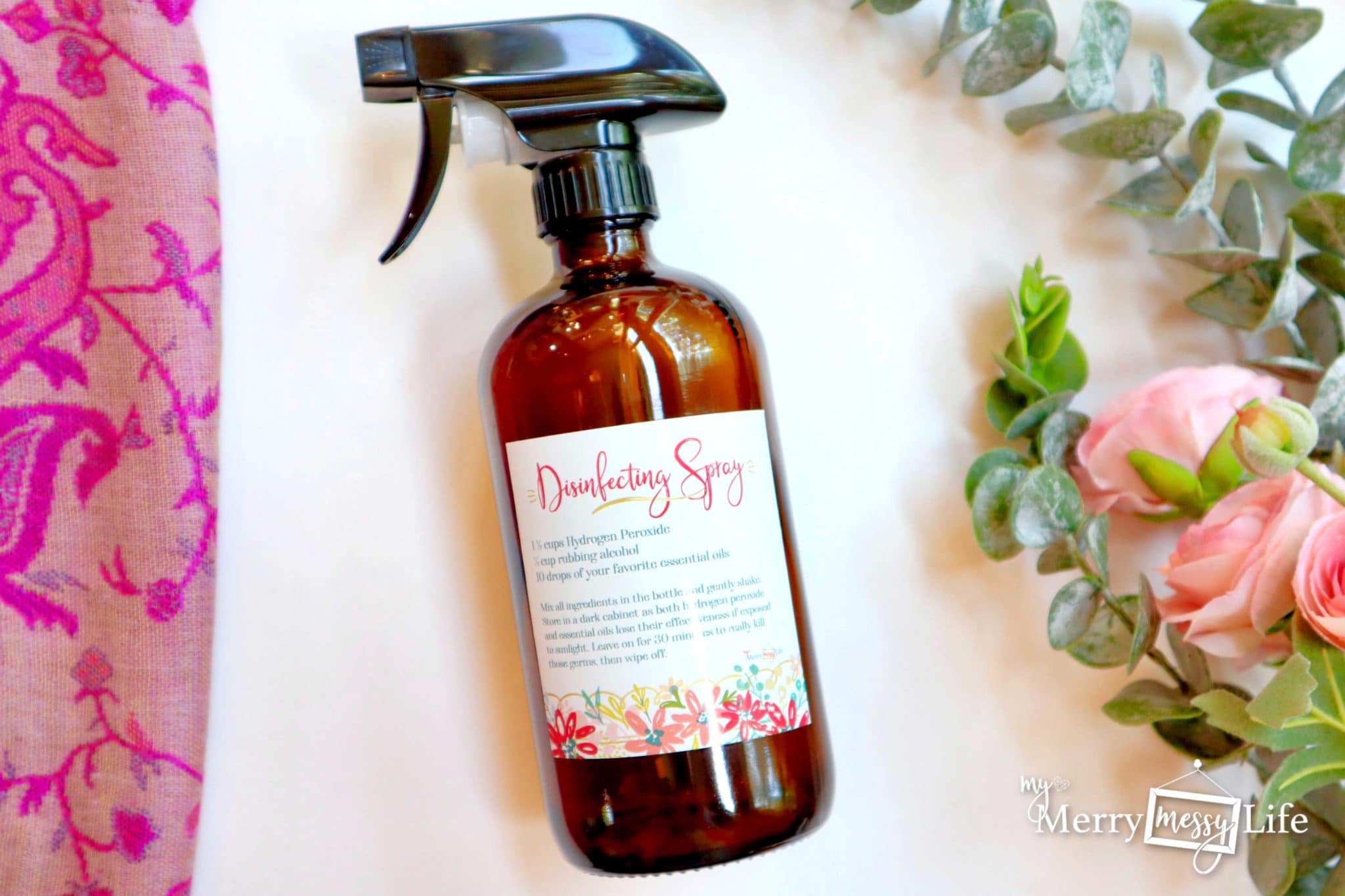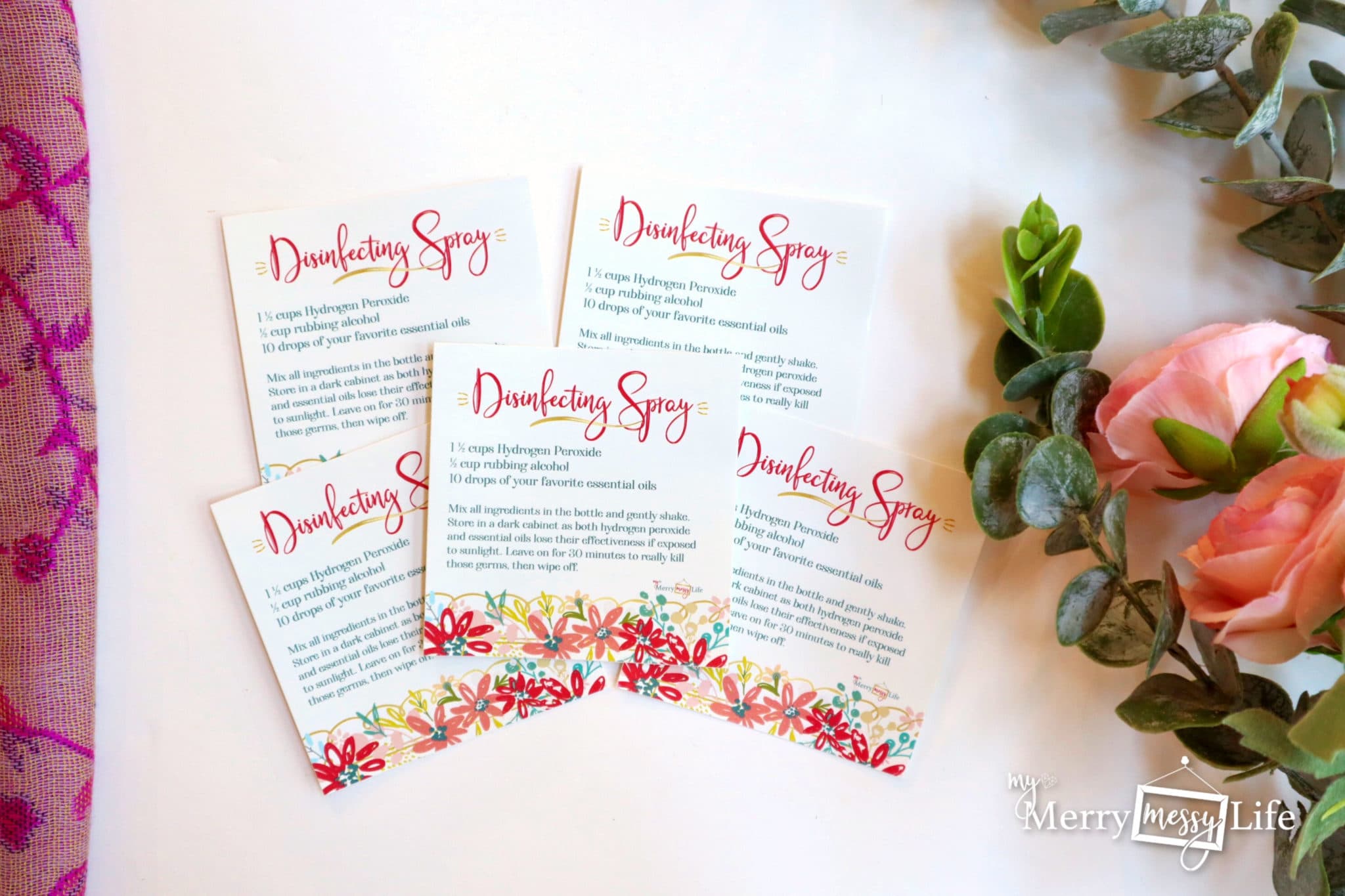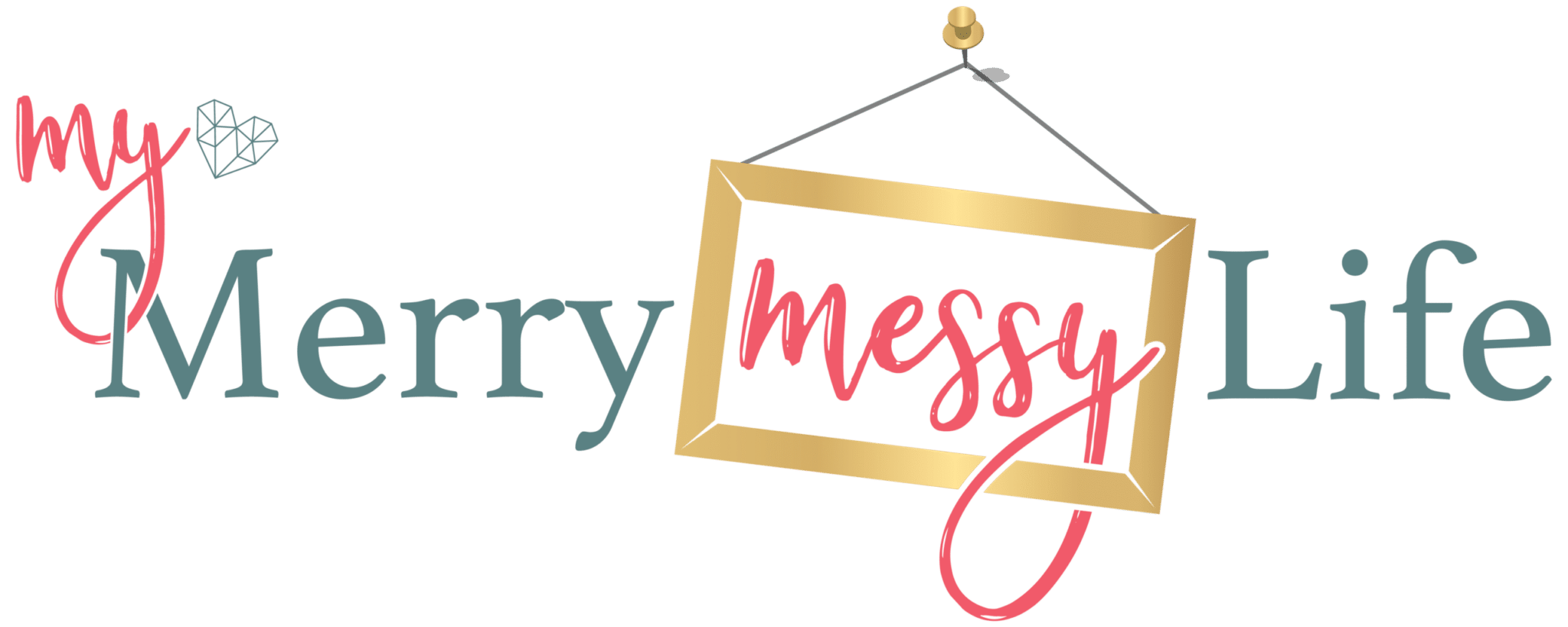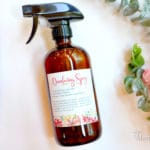Easy Natural Disinfecting Spray to Make at Home
Here's an easy natural disinfecting spray recipe using just three simple ingredients – rubbing alcohol or pure grain alcohol, hydrogen peroxide, and essential oils. Use it on your countertops, cutting boards, toilet seats, doorknobs, faucets, and more without worrying about toxins!

Top 10 Cleaning and Laundry Recipes
This recipe is part of a 10-part series of natural cleaning and laundry recipes. You can find a list of all of the recipes here. This natural disinfecting spray recipe is also found in my book, Detox Your Home, which you can find on Amazon. It includes more than 80+ recipes, research, and lists of natural products you can purchase to help you go natural in your home!
Toxins in Disinfectants
Antibiotic Resistance
The problem with using hand sanitizers, disinfecting sprays, and antibiotics frequently is that it creates antibiotic resistance. Why is this a problem? When we truly need antibiotics for an illness, they aren't as effective.
So, I would also use this sparingly. Use on your countertops and cutting boards when you have handled uncooked meat or when there is a virus going around your home. It can be effective to spray on doorknobs, toilet handles and seats, and faucets, but I recommend only using it when needed, not on a regular basis.
Artificial Fragrances
I’ve often written about the dangers of artificial fragrances on the blog! Artificial fragrances can trigger asthma attacks, worsen allergies, and cause inflammation in the sinuses that can lead to more frequent colds and respiratory infections. That’s why I prefer to scent my homemade products with essential oils.
Fake fragrances disperse particles of formaldehyde and phthalates (thy-lates) into the air. Phthalates are small particles of plastic that are used to bind the artificial fragrance molecules together. We then breathe in those tiny particles of plastic, and they get into our nose and lungs – yuck!
Airborne Toxins
Most disinfecting sprays release formaldehyde, 1-4 Dioxane, and artificial fragrances into the air that we then breathe in. They irritate allergies and asthma, and even some studies have shown they can cause asthma over time with weekly use. They also contribute to more frequent colds and respiratory illnesses.
A growing body of evidence suggests that using cleaning products can also cause asthma to develop in healthy people. A 10-country study of more than 3,500 individuals who were initially free of asthma found that nine years later, those who used spray cleaners at least once a week to clean their homes had a 30-to-50 percent increased risk of developing asthma during the study period (Zock 2007). This association was linked primarily to commonly used spray products such as air fresheners, glass cleaners and furniture cleaning sprays. (source)
Learn About the Ingredients in this DIY Natural Disinfecting Spray
Hydrogen Peroxide
This is a safe and effective disinfectant and alternative option to chlorine bleach. Its molecules are made of two hydrogen and two oxygen atoms (H2O2) that decompose after use back into oxygen and hydrogen, so it’s completely green and nontoxic, and is colorless and odorless to boot. It must be stored in a dark container or cabinet out of direct sunlight as sunlight will break it back down into oxygen and hydrogen.
For household cleaning, the 3% solution is an effective disinfectant if left on for 30 minutes or more. It can also be used as a laundry and upholstery stain remover for light or white items. I wouldn’t use it on colored items as it will remove the color like bleach does.
Another option to get stronger disinfecting power from your hydrogen peroxide is to use the 35% solution, which you can find here.
I have a whole post I wrote just about hydrogen peroxide – see it here!
Rubbing Alcohol
Rubbing alcohol (70% or higher) is very effective in killing germs; however, it can be irritating to the lungs and should be used in a well-ventilated area. The EWG.org gives it a low risk (see here) for asthma and respiratory concerns. The reason I chose it is because it has been proven to kill the flu virus (source) and is much safer to use than, say, Lysol Disinfecting Spray.
You could also use pure grain alcohol, like Ever Clear, which has 90-95% alcohol content.
But if you'd rather not use it, use White Vinegar instead (see below). Though, I cannot say for sure that it'll actually kill germs without the alcohol.
Precautions to Take:
Rubbing Alcohol can destroy the finishes on furniture, so this is better to use on cutting boards, kitchen countertops and other non-porous surfaces.
Also, do not ever mix it with chlorine bleach as the combination of the two creates cholorform – a toxic compound that releases toxic and corrosive fumes (source).
Lastly, it is is flammable so keep it away from flames.
White Distilled Vinegar
Vinegar is completely safe and a very effective window, all-purpose cleaner, and sanitizer. However, studies are very limited on its ability to kill germs, so that is why I recommend using Rubbing Alcohol over Vinegar.
Also, we all know vinegar kinda of stinks. So you can make some citrus-infused vinegar (see my tutorial on that here) to lessen the scent, add your choice of lovely-smelling essential oils to it, or do one of the other two recipes I’ve added here.
In order for it to properly sanitize, leave on the surface for 30 minutes.
Essential Oils
Essential oils are wonderful to use in cleaners. They add extra cleaning and germ fighting power, and also smell wonderful, making the cleaning experience more enjoyable! In my family, we also use them for our health. I only use Young Living Essential Oils as I’ve found them to be the best and most effective ones on the market. They have starter kits that make using oils for your health easier to learn about and have success with! Learn more about their oils here.
PrintDIY Natural Disinfecting Spray Recipe
An all natural disinfecting spray recipe using just three simple ingredients – rubbing alcohol or white vinegar, hydrogen peroxide and essential oils.
Ingredients
- 1 1/2 cups Hydrogen Peroxide
- 1/2 cup Rubbing Alcohol (60% or more) or a pure grain alcohol like Everclear (120 proof or higher)
- 10–15 drops of Lemon, Tea Tree, Thieves, or Citrus Fresh essential oils
- 16 oz. brown amber glass spray bottle
- Waterproof, vinyl recipe label for your bottle or a set of 58 printable cleaning labels
Instructions
Combine all ingredients in a spray bottle. Clean the surface first with my all-natural household cleaner recipe. Then, use this spray on nonporous surfaces such as countertops, toilet handles and seats, cutting boards, faucets, doorknobs, keyboards, phones, etc. Do not use on wood or finished wood surfaces. See also my recipe for natural disinfecting wipes.
Get a Waterproof, Vinyl Label in My Etsy Shop!
You can purchase the natural disinfecting spray recipe label in my Etsy shop. The labels are professionally printed on vinyl, waterproof paper. Having the label on the bottle means you never have to look up the recipe again!
- Get the natural disinfecting spray recipe label by itself here
- Or get a set of printable 10 cleaning and laundry recipe labels here

Would You Rather Buy than Make?
If you'd rather buy your own natural disinfecting spray instead of making it, I totally get it! Here are the ones I recommend:
- Honest Co. Disinfecting Spray
- Seventh Generation Disinfecting Bathroom Cleaner
- CleanSmart Disinfectant Spray
[optin-monster slug=”xs2yggdkacqf5ww9fqqm”]


I am going to make your disinfecting spray as soon as I finish filling in this comment and use it against this coved flu germ that is now prevalent. Thank you for all your information.
You’re so welcome! Thanks for stopping by to leave a kind comment :).
Is this effective against covid? I would think so because of the alcohol, but I’m wondering if you know anything about that?
Thanks for sharing! Looking forward to trying it 🙂
Hi Julieta! This recipe has not been tested in a lab, so I cannot say that it kills COVID for sure. But yes, the CDC officially said that alcohol and bleach do kill COVID at the right dilutions.
Can I use the disinfecting mix homemade on granite ?
Hi,
Can you use this on Fabrics?
Thank you for your information.
Hi Crystal! You could, but I would only use it on light fabrics since it contains peroxide. The peroxide is a natural alternative to chlorine bleach so it can lighten fabrics.
Hello, Thank you for your recipe! I would like to know if I could just mix hydrogen peroxide and essential oils, or with water (?) for disinfectant spray (It’s so hard to find rubbing alcohol out there :/)? If yes, how much hydrogen peroxide should I use? Also, do you know if I could use Pine Sol or maybe mix it with hydrogen peroxide for disinfectant spray? I am sorry for many questions, but I am running out of the disinfectant spray and I need to disinfect my clothes, shoes, and purse every time when I get home, so I really want to know….
Hi Cally! Yes, rubbing alcohol is really hard to find right now. Okay, so can you get Ever Clear? If you can find some Ever Clear (180 proof or higher) at your local packing store it’ll be better. I do love Hydrogen Peroxide as a natural germ killer, but it hasn’t been proven to kill the flu virus like alcohol has, and since you are out working during the pandemic, I personally would use something that’s proven to kill. But that’s me! If you do use the Hydrogen Peroxide only, try using it straight with no dilution to get maximum benefits. Make sure to use clear essential oils – ones with a tint or color to them will stain clothes.
Hello,
Thanks so much for the natural disinfectant recipe. Can you please let us know what can we use to disinfect wood?
Thanks
Hi! Hmm, I would use just hydrogen peroxide – straight up so it’s strong. And it’ll have to be left on for 30 minutes or more in order to really kill germs.
I am an UBER/LYFT driver full time….what do you recommend I could have in my vehicle for utmost safety..spray (homemade) and maybe tydywipes with alittle bleach added…
P.S: I have a brick colored, leather upholstery…( a lot of us will be awaiting your thoughts)….thanks a bunch..
Hi George! I would recommend this spray or making your own disinfecting wipes – recipe here. The wipes might make more sense for you in a car, easier to wipe things down. Now, I don’t know how it’ll affect leather. I’d use it more on the plastic and metal surfaces and spot test a small leather spot. Also I have a recipe for natural hand sanitizer if you’re interested. Lastly, I suggest getting a car diffuser and diffuse some essential oils while driving – those will help to purify the air.
Can a plastic bottle be used? Thanks
Hi Kathy! It can if it has the letters HDPE or PETE on the bottom of it. If you’re not using any essential oils in the recipe, then any kind of plastic will be just fine.
Hello! Just to confirm – would isopropyl alcohol 91% content work, or is the alcohol content too high? Going to make these sprays as well as the disinfecting wipes. Thank you!
Hi Alice! So yes, 91% is what I use and it doesn’t make the content too high, in fact, it ensures that it will kill germs better.
Thank you!
Do you also have a disinfectant spray recipe for granite counter tops? Thanks!
Hi Alice! I don’t have a separate recipe for that, but you could use just Hydrogen Peroxide – it’s not corrosive like alcohol or vinegar is.
The recipe for Disinfecting Spray in your book does not include the rubbing alcohol. The only ingredient is Hydrogen Peroxide and Essential Oils. Is this a typo?
Hi Michelle! No, it’s not a typo, but it’s something I added once the Coronavirus started because alcohol and bleach were the only two proven things to kill it, so I wanted to make sure my spray was safe for our current times. Hydrogen Peroxide has also been shown to kill bacteria, but it wasn’t tested for the Coronavirus.
Sara,
I was wondering why use glass spray bottles?
Thank you for all you do for us?
Shelly
Hi Shelley! I prefer glass as essential oils tend to weaken and break down plastic. I like to use a lot of essential oils in my cleaners and the bottles would break if they were plastic. Thanks for stopping by!
How long does the spray last/effective once made? Thank you
I’m honestly not sure! But it should last a very long time since the alcohol in it kills bacteria. Make sure to store it in a cool, dry place like a cabinet to help with shelf life.
Hi there! Looking forward to making this TODAY!
Just confirming – you would spray and leave on surfaces right, to dry? I am curious what else I can spray this one to clean…countertops, bathrooms, etc.
Thanks!
Hi Lisa! Yes you spray and leave on surfaces – it takes 30 minutes for Hydrogen Peroxide to kill germs. I’m honestly not sure how long it takes for alcohol to kill germs but I do think it’s much shorter.
This has been great for me! I use it to wipe my groceries down when I get home. Just a word of caution , it may turn your skin Chalky white because of the peroxide lol. I have heard this is not dangerous but it just happened to me and it startled me for sure! I had a lot of groceries to wipe down this time so I think it was just too much on my skin. I will use gloves next time. I have been using it all week for one or two items without issue, so I’m still going to keep using it , but with a bit more caution.
Hi Kelly! So glad to hear the spray is working so well for you, and thanks for that note of caution so it can help others.
The CDC recommends 70% alcohol solutions for sanitizing so it seems as though the peroxide and alcohol amounts in this recipe should be switched if you want 70% of the solution to be alcohol. Is that correct?
How should I sanitize color fabrics, rugs and furniture?
Hi Emily! I sanitize colored fabrics in the washing machine with hot water. I don’t know of a natural way to sanitize furniture and rugs – vinegar will leave an awful smell behind and peroxide could lighten the colors. If there is another way, I’d love to know it!
Hi Sara,
I’m looking for ways to sanitize my wooden floor, winter coats, mattress, rug , couch and other furnitures please. I don’t want to use the store bought ones because of the toxins and because I don’t have that much money to spend.
Thank you for the instructions in this page!
Hi! So for your winter coats, I would wash them in hot water or hang out in the sun to sanitize them. As for the mattress, rug and couch, I could make this spray but without the peroxide, as it can lighten fabrics. So make it with just water and alcohol. As for the floor, I wouldn’t use peroxide on it and definitely not alcohol. Alcohol is corrosive to wood. So I would use a vinegar mix, like the one I have in my hardwood floor cleaner recipe here.
I believe you stated that we could use a mixture of hydrogen peroxide and vinegar. I just read that this combination when mixed creates peracetic acid which is toxic. Experts say that they should not be mixed in the same container. Do you have clarification on this?
Thanks to sharing this topic, if you need any Custom Packaging has been one of the best choice for brands, especially the newbies who are looking to launch their new product in the market. They know the many wonders these babies can do for their mascara or any other cosmetic product. So make sure you don’t miss out on the rain shower.
We set standards in the world of printing and packaging with our unique designs and digital printing techniques by giving the products an alluring look that distinguishes our customer’s products.
Thanks for this beautify article. OBT Packaging was founded a few years ago with this ambition to provide premium quality custom boxes to the local US and International market.
Thanks for Sharing the beneficial content. I’ll definitely use these all things to Sanitize my home.
much thank for sharing this informative material, hopefully this will be beneficial for me.
i really suffered and tired to think about this problem that happened to me last 3 years but your blog very help me to sort out this problem and i hope it will good all not for only me. Thanks
Hi, very useful and informative article. I am happy that I found essential knowledge after reading the post. It’s very hard to keep a home clean and disinfect, the most difficult thing is to find the right spray to disinfect the home. Your article solves this issue and every reader has been known which type of spray is beneficial to disinfect a home. Moreover, It is not a big deal to buy natural disinfection spray if you are aware of cashback offers and discount deals coming from cashback websites or online stores.
Thanks for this beautify article. Packwhole was founded a few years ago with this ambition to provide high quality custom packaging boxes to the local USA and UK.
I’m going to make this recipe especially for disinfecting the bathroom
How long does it need to sit on the surface for before wiping ? Or do I just leave it and not wipe?
i love it! Thank you for sharing it. i am so glad that you creativity helped us!
Mips Reporting Services In USA
Top Medical Billing Company in USa